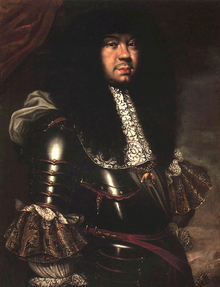Michael I. (Poland)
Michael Korybut Wiśniowiecki ( Polish Michał Korybut Wiśniowiecki , Lithuanian Mykolas Kaributas Višnioveckis ; born May 31, 1640 in Biały Kamień, Poland-Lithuania , today Lviv Oblast , Ukraine ; † November 10, 1673 in Lviv , Poland-Lithuania, today Lviv Oblast, Ukraine ) was a Polish-Lithuanian aristocrat and from 1669, as King of Poland and Grand Duke of Lithuania , the elected ruler of the state of Poland-Lithuania. His father Jeremi Wiśniowiecki came from the Ruthenian magnate family of the Wiśniowieckis , his mother Gryzelda Konstancja Zamoyska was the daughter of Tomasz Zamoyski and granddaughter of Jan Zamoyski . Michael Korybut was also a member of the Order of the Golden Fleece .
Royal title
Titulature in Latin: " Michael I, Dei Gratia rex Poloniae, magnus dux Lithuaniae, Russiae, Prussiae, Masoviae, Samogitiae, Livoniae, Smolensciae, Kijoviae, Volhyniae, Podoliae, Podlachiae, Severiae, Czernichoviaeque, etc. "
German translation: " Michael I, by God's grace King of Poland, Grand Duke of Lithuania, Rus , Prussia , Mazovia , Samogitia , Livonia , Smolensk , Kiev , Volhynia , Podolia , Podlachia , Sewerien , Czernihów etc. "
Life
King Michael Wiśniowiecki was the son of Prince Jeremi Wiśniowiecki (a distant descendant of Rurik or Gediminas ) from the coat of arms community Korybut and Gryzelda Wiśniowiecka, née Zamoyska .
After his election on June 19, 1669, he was crowned king. Four other candidates, among them Philipp Wilhelm von Pfalz-Neuburg , were rejected because the nobles of Poland-Lithuania after bad experiences with foreigners (e.g. with the Wasa house ) voted for a " Piast ", that is, a native candidate wanted to give in contrast to the intentions of the influential magnates who made up the nobility .
During his tenure, the declared Ottoman Empire Poland in 1672 the war , leading to the outbreak of the Ottoman-Polish war from 1672 to 1676 led. In June of the same year a 100,000-strong invasion force under the command of Grand Vizier Köprülü Fâzıl Ahmed under Sultan Mehmed IV besieged the fortress Kamieniec Podolski , which was abandoned on August 26th. Since the commander of the fortress and his crew blew themselves up, the Turks only conquered a ruin. In October, the Treaty of Buczacz was signed, through which the Ottomans received Podolia with the main fortress Kamieniec Podolski, while the Hetman Doroshenko's Cossacks were given the "Right Awkward Ukraine" as vassals of the Sublime Porte .
Michael Korybut Wiśniowiecki died on November 10, 1673. The king's remains were buried in the Wawel Cathedral in Krakow . His successor was the Grand Hetman of the Polish Crown, Jan Sobieski, who was militarily successful in the fight against the Turks , Cossacks and Crimean Tatars .
Marriage and offspring
King Michael was married to Eleanor of Austria , the marriage remained childless.
See also
Web links
Individual evidence
- ↑ Ilona Czamańska , Wiśniowieccy. Monografia rodu, Poznań 2007, p. 249.
| predecessor | Office | successor |
|---|---|---|
| Johann II./I. Kasimir Wasa |
King of Poland, Grand Duke of Lithuania 1669–1673 |
Johann III./II. Sobieski |
| personal data | |
|---|---|
| SURNAME | Michael I. |
| ALTERNATIVE NAMES | Wiśniowiecki, Michał Korybut; Wiśniowiecki, Michael |
| BRIEF DESCRIPTION | King of Poland (1669–1673) |
| DATE OF BIRTH | May 31, 1640 |
| PLACE OF BIRTH | Biały Kamień, Kingdom of Poland , today Lviv Oblast , Ukraine |
| DATE OF DEATH | November 10, 1673 |
| Place of death | Lviv , Kingdom of Poland, today Lviv Oblast , Ukraine |

